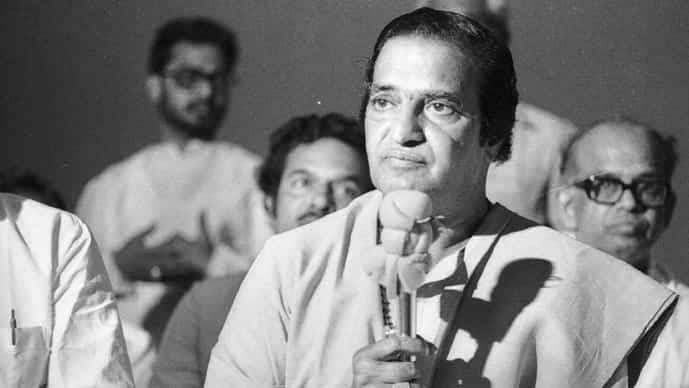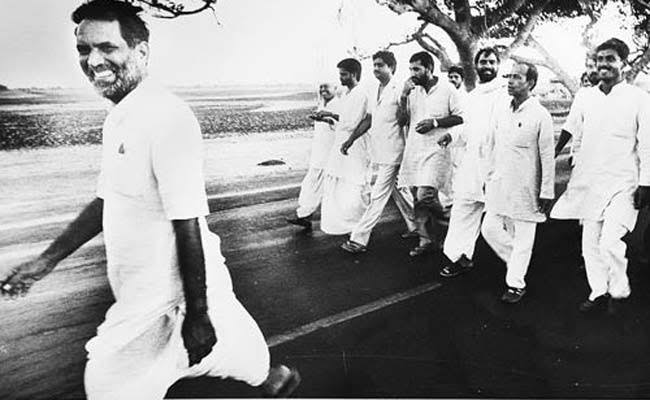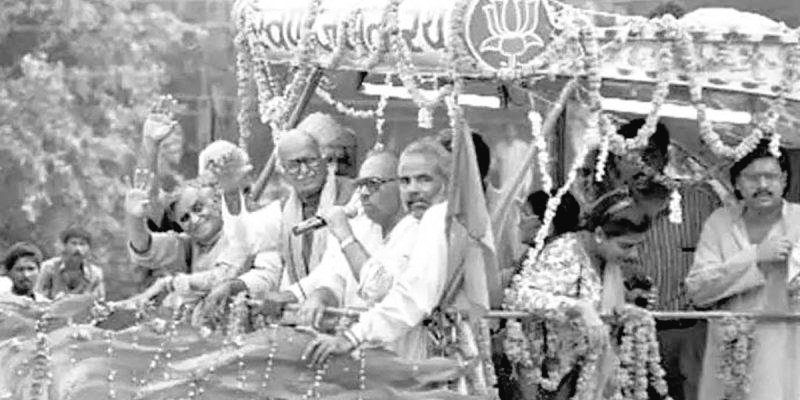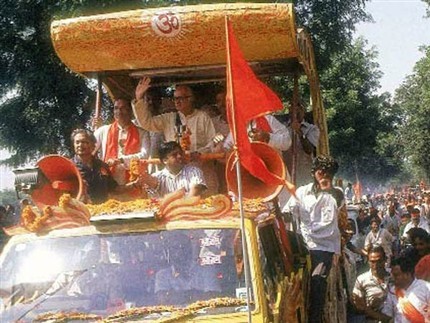
Padayatra politics, from Gandhiji to NTR, Advani, Modi and Rahul
Yatras give political parties a chance to connect with ordinary people; The Federal looks at a few padayatras by leaders that changed the course of politics in the country

Padayatras have always caught the imagination of the people. Be it the historic walk ingeniously designed to protest against an exorbitant salt tax that ended up stoking a nationwide non-cooperation movement against the British empire, or LK Advani’s divisive Rath Yatra that left behind a trail of hate, yatras have been an effective tool for political parties to reach out to voters.
Today, parties of all hues bank on a robust yatra to amplify their message. The AAP, intent on expanding its reach beyond the capital, never misses a chance to launch a yatra. If it has launched the Make India No 1 yatra from Haryana to counter the Congress’ Bharat Jodo Yatra, the AAP has a yatra for every issue in India – be it the 2021 Kisan Mazdoor Khet Bachao Yatra from Rohtak to Palwal in Haryana to raise the problems of farmers, or the ’employee guarantee yatra’ before the Uttarakhand elections last year.
Also read: 10 things about Congress’ massive foot march, Bharat Jodo Yatra
To change the perception of the people about the government’s handling of the COVID, the ruling BJP too opted for a five-day Jan Ashirwad Yatra last August, dispatching 39 Union ministers to cover 22 states. West Bengal Chief Minister Mamata Banerjee took out massive padayatras across the state in the run-up to the 2011 Assembly elections. It was one of the factors that led to the defeat of the Left Front, which had enjoyed 33 years of power in West Bengal.
Political observers say that yatras give political parties a chance to connect with ordinary people in different places and it remains a powerful tool for mobilising the masses in a vast country like India. It turns out to be a democratic activity that helps to forge a lively relation with the people.
With an eye to restore its electoral fortunes, the Congress’ mega 3,570 km Bharat Jodo Yatra, from Kanyakumari to Srinagar, is also clearly a desperate attempt to leverage the power of yatras. Meanwhile, here’s a list of some of the major yatras that changed the course of history in the country.
Mahatma Gandhi’s Dandi March
It was a turning point in India’s freedom struggle. The Dandi March, which Mahatma Gandhi undertook from Sabarmati Ashram to Dandi, a distance of 240 km, was to ostensibly protest against the steep tax levied on salt by the British. But it marked the inauguration of the Civil Disobedience Movement, and was easily the most significant organised movement against the British Raj, after the Non-Cooperation Movement of the early 1920s.
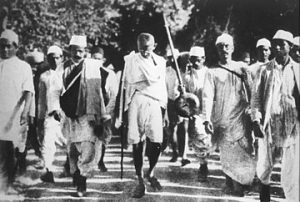
The Dandi March started from Sabarmati Ashram on March 12, 1930. At exactly 6.30 in the morning, Gandhiji left the ashram with 79 followers and started the march. During this period, he used to address gatherings and his speeches were successful in influencing the minds of the people against the policies of the British. Many Indians joined them along the way as Gandhiji and the others continued on what would become a 24-day march to Dandi in order to produce salt without paying the tax.
This walk by a disciplined band of non-violent satyagrahis presented a new model of satyagraha which later on converted into a bigger movement at an all-India level. The British colonial rule itself came under pressure after this highly publicised salt march.
Subsequently, Gandhiji did the 1946-47 Peace Marches aimed at bringing Hindus and Muslims together.
NTR, pioneer of rath yatras
It was the mother of all yatras, as the ‘Chaitanya Ratham Yatra’ embarked on its 40,000 km journey. The founder of the Telugu Desam Party, NT Rama Rao (NTR), toured Andhra Pradesh four times in nine months. Throughout the yatra, the actor-turned-politician ate at roadside hotels, slept in his rath (his old Chevrolet was converted into a chariot) or under trees, took bath on the roadside and returned to Hyderabad only after the announcement of Assembly elections in January 1983.
People used to wait for days camping on the roadside, bringing along stoves, utensils and mats just to hear NTR. Villagers would post one person on the main road to signal them at the sight of NTR’s rath and women would welcome him with an arthi and ask him to name their newborn kids.
According to media reports at that time, it is no exaggeration to say that NTR’s yatra executed in grand celluloid style was matchless in terms of sheer drama, curiosity, and the people’s response it generated.
Chandra Shekhar’s Bharat Yatra
Janata Dal leader and former Prime Minister Chandra Shekhar undertook a padayatra, the Bharat Yatra, in January 1983. He began the 4,260 km march after installing Ramakrishna Hegde as Karnataka Chief Minister.
Chandra Shekhar used the donations received during the padayatra to establish Bharat Yatra centres across India, Although the padayatra was largely a success, dramatic political developments like Indira Gandhi’s assassination whittled down the effect. In the 1984 elections, he lost to Jagannath Chaudhari, as the Rajiv Gandhi-led Congress swept the general elections after Indira Gandhi’s assassination. This was the only Lok Sabha election that Chandra Shekhar lost in the course of three decades of his parliamentary journey.
‘Raja of Manda’ VP Singh pipped Chandra Shekhar to become the leading candidate of the Opposition towards the end of that decade. After the VP Singh government collapsed following the withdrawal of support by the BJP, Chandra Shekhar also left the Janata Dal with 64 MPs and formed his new party Janata Dal (Samajwadi).
On November 10, 1990, Chandra Shekhar formed the government with the Congress’s support from outside, and became India’s ninth PM albeit for a short period before the grand old party pulled the plug.
LK Advani’s rath yatra
This yatra completely changed the course of India’s secular history. LK Advani’s Somnath to Ayodhya Rath Yatra, held months ahead of the 1991 Lok Sabha election, no doubt helped the BJP to improve its tally in the national polls that year. It also marked the BJP’s launch of the Ram Temple plank.
The symbols of Advani’s march were ‘religious, allusive, militant, masculine, and anti-Muslim’. The yatra was a major contributory factor to the horrific communal violence of the 1990s and beyond. As Khushwant Singh bluntly told Advani to his face, “you have sowed the seeds of communal disharmony in the country and we are paying the price for it”.
Though Advani never managed to reach Ayodhya, the yatra changed the BJP’s fortunes. From 85 seats in the 1989 Lok Sabha elections, the party went on to bag 120 seats in 1991. The yatra managed to whip up a strong Hindu fervour and served as confirmation of the idea that religion could decide electoral fortunes.
“I had never realised that religiosity was so deep-rooted in the lives of Indian people,” Advani said in his autobiography My Country My Life. “It was during the Ram Rath Yatra that I first understood the truth of Swami Vivekananda’s statement that ‘religion is the soul of India and if you want to teach any subject to Indians, they understand it better if it is taught in the language of religion”. Also, he wrote: “It was the Rath Yatra that made me realise that, if I were to communicate the message of nationalism through the religious idiom, I would be able to transmit it more effectively and to a wider audience”.
Advani was not able to complete the yatra because he was arrested in the wee hours of the morning on October 23 in Bihar at Samastipur and held captive at Massanjore. The overwhelming response to Advani’s rath yatra drove many political parties to deploy this strategy to reach out to the masses. Today, the BJP is the largest political party in the country, thanks to the journey that began from Somnath during the Navaratri of 1990.
Advani also held a Janadesh Yatra in September 1993 against the 80th Amendment Bill and the Representation of People (Amendment) Bill; and the Swarna Jayanti Rath Yatra, from May 18, 1997, to celebrate 50 years of India’s independence and the Bharat Suraksha Yatra.
In April 2006, he launched a yatra to convince the masses that the UPA government was not serious about tackling terrorism. This yatra, which ended on May 10, 2006, was split into two campaigns — one led by Advani, Leader of the Opposition (Lok Sabha), from Dwaraka in Gujarat to Delhi; and the other led by Rajnath Singh, party president, from Jagannath Puri in Odisha to Delhi.
BJP’s Ekta Yatra
The Ekta Yatra or National Integration Rally is the name of two political yatras or rallies led by the BJP in India. The first began in 1991, following the 1990 Ram Rath Yatra, and the second was held in 2011. Each rally travelled through various Indian states and ended with the unfurling of the flag of India in J&K.
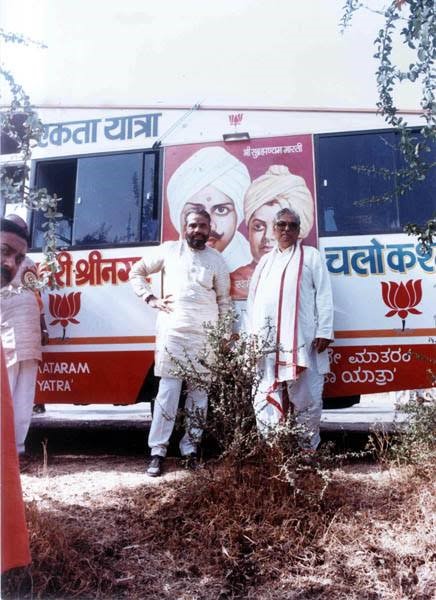
The 1991 Ekta Yatra, led by then BJP president Murli Manohar Joshi, was intended to signal that the BJP supported national unity and opposed separatist movements. It began on 11 December in Kanyakumari, and he visited 14 states. Other notable participants included Narendra Modi, who helped organise the rally. The rally culminated with him getting airlifted to Srinagar and unfurling the national flag at Lal Chowk in Srinagar on 26 January 1992. It was considered to have minimal success, as few locals participated.
The 2011 Ekta Yatra was led by BJP youth wing national president and Lok Sabha member of Parliament Anurag Thakur. The rally started in Kolkata, West Bengal on January 12, travelled through Jharkhand, Bihar, Uttar Pradesh, Maharashtra, Madhya Pradesh, Rajasthan, Punjab, and Haryana, and ended with the unfurling of the flag on January 26 in Lal Chowk, a city square in Srinagar, Jammu and Kashmir in 2012.
In Joshi’s view, yatras are age-old in our civilisation. Indian scriptures talk about life’s journey being like a yatra. ‘Charaiveti, charaiveti’, or ‘keep moving, keep moving’, are words from a hymn in the Aitareya Upanishad, urging the traveller to keep going regardless of setbacks and obstacles.
Modi’s Gujarat Gaurav Yatra
After resigning from his CM post and recommending the dissolution of the Gujarat Assembly nine months before its term was scheduled to end, Narendra Modi launched the Gujarat Gaurav Yatra in September 2002. His aim: to appeal to the “pride of the people of Gujarat”.
The yatra proved to be a great success with the BJP coming to power with an absolute majority in the 2002 Assembly elections. Modi was sworn in for a second term as chief minister. The elections took place in December, months after communal riots in the state. The BJP kicked off a similar yatra in Gujarat ahead of the 2017 Assembly elections and the party emerged victorious.
YSR: Giving padayatras a new meaning
Congress stalwart YS Rajasekhara Reddy gave padayatra politics a new meaning. In 2003, when he was heading the Congress in united Andhra Pradesh, YSR embarked on a 1,500-km padyatra over 60 days to focus on the difficulties faced by the people due to drought and the TDP government’s alleged apathy towards farmers. He managed to strike a chord with the people and swept to power in the 2004 assembly elections.
The late YSR’s son Jagan Mohan Reddy continued the padayatra legacy and took a Praja Sankalpa Yatra in 2018 to reach out to people in post-bifurcation Andhra Pradesh. His party, the YSR Congress, went on to win 151 of the 175 assembly seats and 22 of the 25 Lok Sabha seats from the state.
BJP’s Vel Yatra in TN
Here’s a unique kind of yatra. Trying to make a dent in the South, the BJP, in November 2020, ahead of assembly polls in Tamil Nadu, held a Vel Yatra (vel or spear is a symbol of Lord Muruga), covering six major Murugan shrines. Though the Vel Yatra did not bag them political gains in the assembly elections, the BJP was content it had made enough noise to establish its presence.
Digvijaya Singh’s spiritual journey
In September 2017, Digvijaya Singh started his six-month-long religious journey ‘Narmada Parikrama’ from the Barman ghat in Narsinghpur district, situated on the banks of the Narmada. The coordinator of the 2022 Bharat Jodo Yatra, Digvijaya maintained the 3,000-plus-km ‘Narmada Parikarma’ along the banks of river Narmada is entirely a religious and spiritual exercise.
It was not political, he asserted but political observers felt otherwise. Through this exercise, they felt Digvijaya Singh was trying to stay politically relevant.
(All photos: Twitter)


